Manchester United Football Club was formed in 1878 as Newton
Heath LYR Football Club by the Carriage and Wagon department of the Lancashire
and Yorkshire Railway depot at Newton Heath. The team initially played games
against other departments and rail companies at their home ground at North
Road, but by 1888 the club had become a founding member of The Combination a regional football league.-
"(The first Combination was set up in 1888, the same year the Football League was founded.It consisted of 20 teams, although this proved too many teams for each one to play the other once, let alone twice. Instead each club was to play eight others home and away, making 16 games in total. However unlike the League,the Combination was not centrally organized, but left to individual clubs; as a result confusion ensued, as it was not clear whether many matches between clubs were friendlies or Combination matches. Many fixtures were left unfulfilled, and the Combination was wound up in April 1889)",
However, following the league's dissolution before the end of its first season,
Newton Heath joined the newly formed Football Alliance, which ran for three
seasons before being merged with The Football League. This resulted in the club
starting the 1892–93 seasons in the First Division, by which time it had become
independent of the rail company, dropped the "LYR" from its name and
moved to a new ground at Bank Street. After just two seasons, the club was relegated
to the Second Division.
In January 1902, with debts of £2,670 – equivalent to
£250,000 as of 2013 – the club was served with a winding-up order. Captain
Harry Stafford found four local businessmen – including John Henry Davies, who
became club president – each willing to invest £500 in return for a direct interest
in running the club. As a mark of this fresh start, on 24 April 1902, the
club's name was changed to "Manchester United". Under Ernest
Mangnall, who became club secretary in 1903, the team finished as Second
Division runners-up in 1906 and secured promotion to the First Division, which
it won in 1908 – the club's first league title. The following season began with
victory in the first ever Charity Shield and ended with the club's first FA Cup
title. Manchester United moved to a new stadium at Old Trafford in 1910, and
won the First Division for the second time in 1911, but at the end of the
following season, secretary Mangnall left to join Manchester City.
In 1922, three years after the resumption of football
following the First World War, the club was relegated to the Second Division,
where it remained until regaining promotion in 1925. Relegated again in 1931,
Manchester United became a yo-yo club, achieving its all-time lowest position
of 20th place in the Second Division in 1934. Following the death of John Henry
Davies in October 1927, the club's finances deteriorated to the extent that
Manchester United would likely have gone bankrupt had it not been for an
investment of £2,000 in December 1931 by James W. Gibson, who assumed control
of the club.[9] In the 1938–39 season – the last year of football before the
Second World War – the club finished 14th in the First Division. During the
war, the club participated in the Wartime League and the Football League War
Cup, but in 1941, Old Trafford was damaged by German bombs and would not be
fully repaired until 1949.


No comments:
Post a Comment